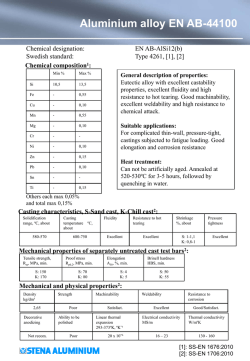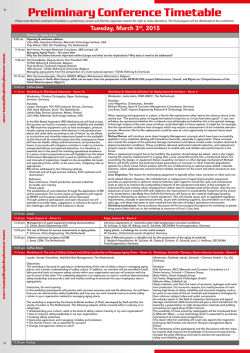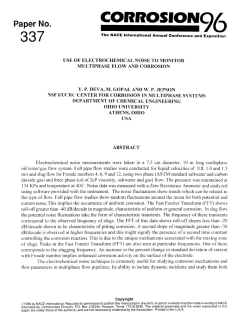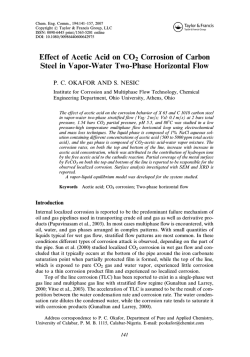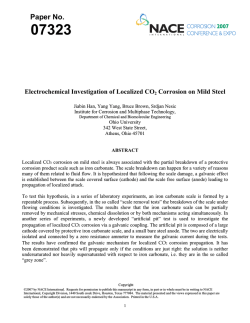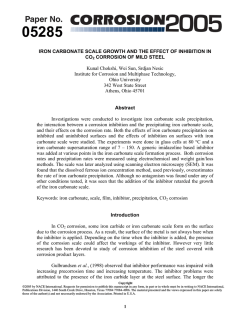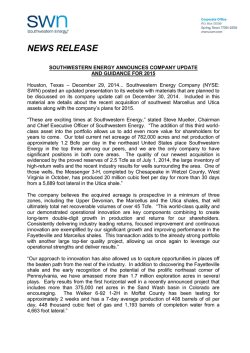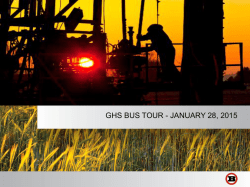
OXYGON™ Oxygen Scavenger Helped Reduce
CASE STUDY DEEP WATER Corrosion Control Additives OXYGON™ Oxygen Scavenger Helped Reduce Corrosion in Deep Vertical Wells Location: Rio Gallegos, Argentina Overview A combination of high fluid densities, deep wells and elevated bottom hole temperatures proved to create a corrosive environment for the operator’s rented drillpipe. Although general corrosion was controlled down to very acceptable rates, signs of pitting corrosion were observed on corrosion rings. Pitting corrosion is an extremely localized form of attack which can rapidly perforate metal. Pitting can be far more damaging than general surface corrosion. Baroid was asked to investigate the corrosion mechanisms and control the damage. Corrosion Inhibitor Concentration Corrosion Rate Comparison Fig 1. The above graph depicts the concentrations of BARASCAV ™ L oxygen scavenger, BARACOR® 700 filming agent, and OXYGON™ oxygen scavenger used to treat corrosion on wells 1-4. An initial corrosion test was performed on Well #1, followed by corrosion testing at different depths on the three subsequent wells. Fig 2. Fig 1. The above graph depicts the corrosion rates of wells 1-4 at various depths. Corrosion rates lowered drastically after the addition of OXYGON™ oxygen scavenger on the third well. CHALLENGE SOLUTION RESULT High fluid densities, deep wells and elevated bottom hole temperatures lead to corrosion issues on the operator’s rented drillpipe. Although general corrosion was controlled down to very acceptable rates, signs of pitting corrosion were observed on corrosion rings. Baroid employed a corrosion control package based on BARACOR® 700 filming agent and BARASCAV™ L oxygen scavenger. Although there was good control of corrosion rates, the test rings showed signs of pitting, a particularly damaging form of corrosion. The oxygen scavenger was substituted with OXYGON oxygen scavenger. Not only did the use of the OXYGON scavenger reduce general corrosion rates on the drillpipe, but pitting corrosion was eliminated. The operator realized immediate cost saving in all operations by minimizing drillpipe damage. This helped to avoid costly NPT, leading to a savings of about USD 76,800. Solving challenges.™ Baroid CASE STUDY The use of water-based fluids in high temperature environments can encourage corrosion damage due to dissolved oxygen. Often the action of corrosion inhibitors alone is not sufficient to provide protection of exposed steel in the hot, dynamic environment. To effectively minimize corrosion in these circumstances, low oxygen concentrations must be maintained using chemical scavengers. The effective application of oxygen scavengers in a circulating system requires the use of special mixing, circulating and analytical procedures. Baroid anticipated drillstring corrosion and employed a control package based on BARACOR® 700 filming agent and BARASCAV™ L oxygen scavenger in order to reduce corrosion damage to the drillstring. BARACOR 700 filming agent is a phosphonate-based inhibitor with an action that both films and passivates metal surfaces. BARASCAV L scavenger is a liquid-form inorganic oxygen scavenger. A direct reaction in solution reduces dissolved oxygen concentrations and its corrosive effects. The effectiveness of this treatment was monitored using ring coupons. Implementation of Baroid’s corrosion control package reduced corrosion rates down to acceptable levels as low as 1 lb/ft2/yr. Industry standards suggest that drillpipe corrosion should not exceed 2 lb/ft2/yr. Although there was good control of corrosion rates, the test rings showed signs of pitting, a particularly damaging form of corrosion. Based on technical investigations and developments, the oxygen scavenger was substituted with OXYGON oxygen scavenger. Unlike BARASCAV scavenger, the OXYGON organic scavenger has a rapid, irreversible action on dissolved oxygen. Not only did the use of the OXYGON scavenger reduce general corrosion rates on the drillpipe, but pitting corrosion was eliminated. In addition, the OXYGON scavenger is effective at lower concentrations than BARASCAV scavenger. This very effective treatment has been maintained in the drilling of all subsequent wells. As a result of implementing Baroid’s customized corrosion treatment, the operator was provided with the following benefits: • Reduced corrosion rates to minimal levels • Eliminated pitting, erosion and corrosive effects on rented drillpipe • Realized immediate cost saving in all operations by minimizing drillpipe damage This helped to avoid costly NPT associated with twist off events and consequent fishing operations which average about 4 days. As a consequence of the treatments performed and taking into consideration that daily rig rate is USD 19,200; customer savings were about USD 76,800. www.halliburton.com Sales of Halliburton products and services will be in accord solely with the terms and conditions contained in the contract between Halliburton and the customer that is applicable to the sale. 01/2015 H011532 © 2015 Halliburton. All rights reserved.
© Copyright 2025
